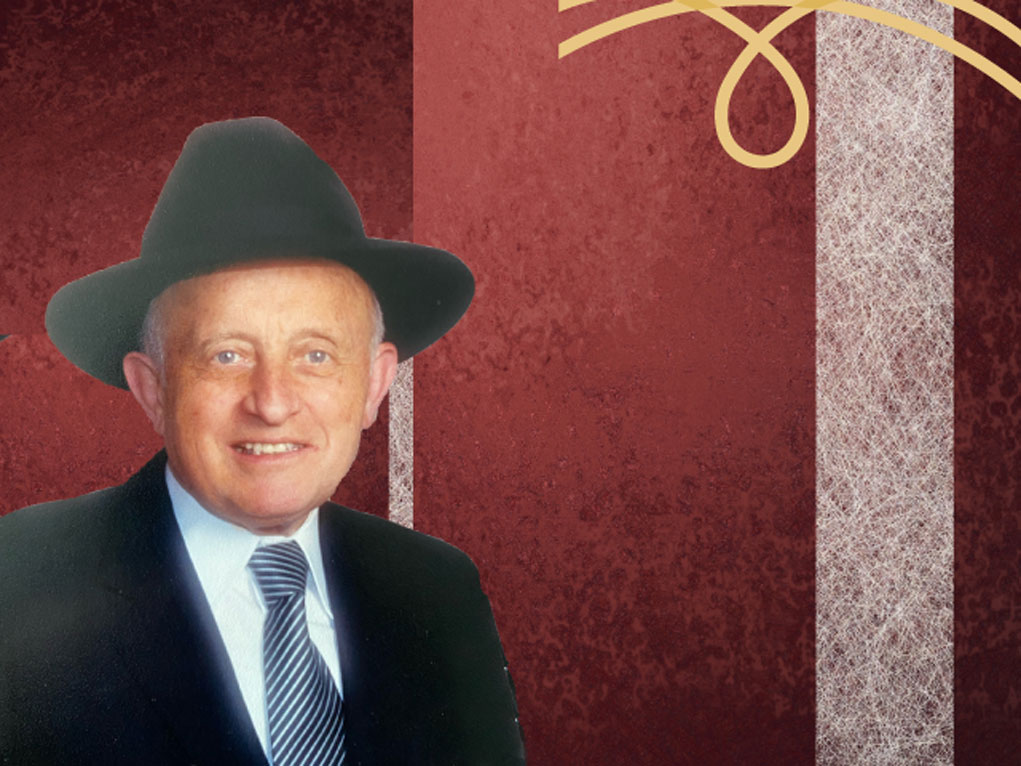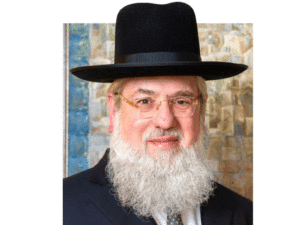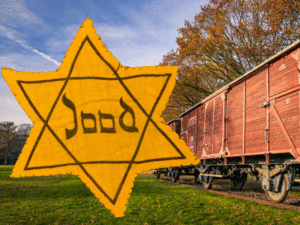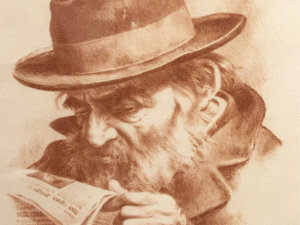By Baruch Weiss
This past Shabbos Chanukah, at the time of raava d’raavin, one of the great lights of the Toronto kehillah ceased burning. Reb Nosson Nota Yitzchok (Sandy) Hofstedter was a paragon of hachzokas Torah and community activism. Rising from the ashes of the Holocaust, Mr. Hofstedter was zoche to build a family, a city, mosdos haTorah, and a real estate empire. He was a visionary who personified the Yiddishe neshomah that refuses defeat. Chanukah, the yom tov that represents this indomitable spirit, was indeed a fitting time for his ascent to shomayim.
The name Hofstedter is, today, synonymous with philanthropy and success on numerous fronts. However, it is important to realize that over the course of Mr. Hofstedter’s life, he had to contend with as many challenges as he did successes. He came from a large extended family of grandparents, aunts, uncles, and cousins, the majority of whom perished in the war. He came from a wealthy home, but had to start from scratch after the war. And lastly, upon his arrival in Canada, he had to fight an uphill battle for the sake of pure chinuch in Toronto.
MEZOKOVESD
Nosson Nota Yitzchok was born on August 18, 1924, in Mezokovesd, Hungary, to Reb Zev (Willy) and Matel Hofstedter. As a young boy, he was known to his friends and family as Sanyi (pronounced “Shauni”). Later, upon his arrival in North America, he became known to business associates as Sandor and to friends and family as Sandy.
Sandy’s parents were baalei chesed and imbued in him a sense of responsibility to the klal from a young age. Every Erev Pesach, his mother used to make oil from fattened geese and send it to poor families in Mezokovesd together with some meat. Sandy was often the courier for such deliveries, learning to take care of others from this hands-on experience. Similarly, his father, who operated a large wine business, would send Sandy to deliver wine to poor families on Erev Pesach. Sandy would go down to the cellar and lug the heavy barrels of wine to the cart. He would then travel a half hour by horse and wagon to deliver the wine. At the first Seder, he and his mother would often fall asleep from their Erev Pesach exertions.
In a fascinating memoir compiled by his son-in-law, Reb Mordechai Mandelbaum, Mr. Hofstedter portrays his hometown of Mezokovesd and the surrounding areas. One of his earliest memories was of leil selichos; around 300 to 400 people gathering in shul at 4:30 a.m., many having immersed in the mikvah beforehand. In vivid detail, Mr. Hofstedter describes the palpable eimas hadin that permeated the air.
A central theme which emerges from his description of life in Hungary is the profound impact of the Chasam Sofer and his successors upon religious life in the region. The rabbonim of Oberland strictly upheld the shittos and minhogim of the Chasam Sofer. Indeed, at the levayah in Toronto, Mr. Hofstedter’s son Rav Dovid, nosi of Dirshu, related how numerous roshei yeshiva and rabbonim told him how, when they would speak to his father, they would literally feel the imprint of the Chasam Sofer.
Although Mezokovesd was not a chassidish town, Sandy’s father had a special affinity for rebbes and had tremendous emunas chachomim in their advice and brachos. Reb Zev would travel to the Minchas Elazar in Munkacs and come home excited and inspired. Another memorable incident from Sandy’s early youth was when, in 1933, his father made a chanukas habayis for their new home. In honor of the occasion, he invited Rav Sholom Eliezer Halberstam of Ratzfert, son of the Divrei Chaim of Sanz, for the entire weekend.
In his memoir, Mr. Hofstedter describes the event. The first stop Rav Sholom Eliezer made upon entering Mezokovesd was at the home of the rov. On Shabbos, the rov — who wasn’t chassidish — returned the honor by attending the rebbe’s tisch. Over the course of that Shabbos, nine-year-old Sandy received numerous brachos from Rav Sholom Eliezer. On Motzoei Shabbos, many people from the neighboring towns and villages came to be mekabel ponim, receive brachos, and give the rebbe kvitlach.
At the young age of five, Sandy was enrolled in the local cheder, and at around the age of 10 entered the town’s yeshiva, which was run by the rov and his son, the dayan. Around the time of 1938-39, when Munkacs and other parts of the former Czechoslovakia became reunited with Hungary, Sandy was sent to learn in the town of Kasho, at the yeshiva of Rav Shmiel Schwartz. Both Rav Shmiel and the yeshiva had a profound impact on young Sandy, and he would often reminisce about the two years he spent in Kasho.
As Mr. Hofstedter recalled, there were approximately 110 boys in the yeshiva — 75 in the regular shiur and 35 older boys who only attended the rosh yeshiva’s sugya shiur. Each day of learning would begin at 8:30 a.m., with Rav Schwartz delivering a shiur in Chovos Halevavos (per the minhag of the Chasam Sofer). Rav Schwartz would begin to read from the Chovos Halevavos, but after a few minutes he would become so emotional that he would have to stop. Mr. Hofstedter related that although he could not recall the words taught during those mussar shiurim, the unspoken messages conveyed by his holy rebbi remained with him forever.
Every week, the boys would cover two blatt of Gemara, Rashi, Tosafos, Maharam, and Maharsha. They would learn b’chavrusa until 10:30 a.m. and Rav Schwartz would then give a shiur until 12:30 p.m. In addition to the two blatt a week, the boys would also learn a different sugya each month, with all the meforshim that the boys could find. The rosh yeshiva would deliver a shiur on the sugya three times a week. The boys also had an official seder to finish the entire week’s sedra with Rashi. All aspects of the yeshiva’s style of learning were modeled according to the shitah of the Chasam Sofer.
Sandy’s father, being a man of means, did not want his son to eat teg at the homes of the townspeople in Kasho and arranged for him to sleep and eat all his meals at the home of Rav Schwartz. Mr. Hofstedter describes the uplifting experience of living in the home of such an adam gadol. On Shabbos, when Rav Schwartz would sing yiboneh hamikdosh, he would often start to cry. He would then catch himself, saying “It’s Shabbos, and we must not cry.”
The yeshiva possessed a powerful ruach, and although they were never formally encouraged to do so, many of the bochurim would rise as early as 4:30 in the morning and learn in the neighborhood kloiz. In town, everyone knew “Rav Shmiel’s bochurim,” and being part of the group was a mark of distinction. After two years in Kasho, Sandy returned to Mezokovesd and continued to learn with the town’s rov.
WAR
The official Nazi invasion of Hungary and the implementation of the Final Solution against its Jews took place in 1944, much later than that of Poland, Germany, and Austria. There was hardly any reliable means of communication in those years, and many Hungarians were unaware of the atrocities being carried out against their brothers and sisters across the border. However, even though Hungary was able to retain some autonomy during the early war years, the anti-Semitic right-wing factions of the government already began enacting anti-Jewish decrees in 1938.
In 1939, the government decreed that all licenses to sell state monopoly articles that were held by Jews were to be withdrawn. Thus, Reb Zev Hofstedter and his family, who were wine merchants by trade, were one of the first Jewish families in Hungary to be affected by the decrees. As Mr. Hofstedter recalled, this period was particularly difficult for his family, as their wine business was usurped from them and they watched as a local gentile took it over.
Soon after the Nazi invasion of Hungary in March 1944, many young and able-bodied Jewish men were conscripted into the munkatabor, forced labor battalions who dug trenches and cut trees to help the Hungarian war effort. Sandy, a young man of 20, was summarily conscripted and sent to a number of work locations. He and a group of other frum men subsisted on bread and vegetables as they worked out in the cold from early in the morning until late at night —completely unaware that their families at home had been herded into ghettos.
At a work site in the town of Fulek, Sandy used his ingenuity and wit. When the regiment commanders inquired if there was a shoemaker among them, he stepped forward and offered his services. Although he had never fixed a shoe in his life, he had, as a young boy, often observed a shoemaker in his hometown, and he hoped he could figure things out.
Sandy told the commander he would need some tools and was given permission to go into town with a soldier escort. As they approached the local cobbler, Sandy turned to his escort. Still in possession of some money he had brought from home, Sandy gave some to the soldier and told him to go enjoy himself while he would speak to the shoemaker.
Entering the shop, Sandy explained to the craftsman that he would need a few basic instructions and some direction regarding the tools he would need, and the shoemaker obliged. Working as a shoemaker enabled Sandy to stay indoors, thus avoiding the biting cold. It also gave him access to the camp’s kitchen, and for the next few months, he would cook potatoes and other such items for himself and the other frum soldiers.
In October 1944, the Nazis ordered the Hungarians to dismantle the work camp and march all the Jewish soldiers towards Germany by way of Austria, with different regiments mingling together. After a few weeks of marching, Sandy met his father and his brother Imi, who had been conscripted into a different regiment. His mother, on the other hand, had tragically been shipped to Auschwitz and was promptly murdered upon her arrival.
At some point along the march, Sandy managed to get hold of one of Raoul Wallenberg’s famous schutzpass which ostensibly gave a person Swedish immunity. With it, Sandy was able to travel back to Budapest and try to find a way out of the country. A few days later, his father and brother got ahold of schutzpasses as well, and joined him in the Swedish safe house in Budapest. However, on the morning after the three of them were reunited, the Hungarians dragged them out of the house and marched them to the train station, where they were jammed into cattle-cars and shipped off to the town of Koszeg. Over the course of a harrowing journey of five to six days without any food, many of the car’s “passengers” died.
Koszeg was a Nazi labor camp, where inmates were forced to work all day in the freezing weather, cutting trees and digging trenches while being fed close to nothing. After a few days in the camp, hundreds of inmates began to drop dead out of sheer starvation. Again, posing as a shoemaker, Sandy was able to avoid working out in the cold, and his father and brother miraculously got jobs indoors as well.
In early March of 1945, with the Russians quickly approaching, the Germans shut down the camp and marched the remaining prisoners to Austria. They trekked over the Alps, walking around 30 kilometers a day. At this point, the Hofstedters had a close brush with death. As they journeyed over a hill, they saw a one-armed Nazi standing at the bottom, indiscriminately shooting everyone in sight. The Nazis were still pushing them forward, so running in the opposite direction was not an option. Miraculously, as they neared the one-armed murderer, he stopped shooting, apparently done for the moment. (Mr. Hofstedter would recount this experience at family simchos, saying that Hashem had decreed that he survive, and that he was determined to make his life count).
After a few weeks, they arrived at the Mauthausen concentration camp. There, they encountered people who were nothing more than skin and bones and saw for the first time the dreaded crematoriums. But they were soon transferred out of Mauthausen and marched to Gunskirchen, another concentration camp where people were dying from starvation every day. The only work that the Nazis forced the inmates to do there was bury the dead.
At that point, Sandy and his brother met a friend of theirs from Mezokovesd. One day, the three of them were walking when a Nazi yelled that he needed help. Knowing that he wanted them to help bury some of the dead, they decided to pretend they didn’t hear him. The Nazi began to shout and ran toward them, and the three men ran towards the barracks, with the Nazi in pursuit. The Nazi began to shoot and, although the Hofstedters made it inside, their friend caught a bullet, dropping dead before their eyes.
LIBERATION AND MARRIAGE
On May 5, 1945, the US Army liberated Gunskirchen. In the weeks following liberation, the three Hofstedters found themselves in hospital, suffering from typhus and other ailments. B’chasdei Shomayim, they were able to recuperate and make it back to Hungary.
They found Mezokovesd in shambles; only 20 people from the town’s original 1,200 survived the war. Every movable piece of furniture had been taken from their home, and it was in terrible shape. Nevertheless, the Hofstedters did their best to put things together and even found a few things they had hidden.
It was clear to Sandy that he could not stay in Hungary; the magnitude of the destruction cried out from every corner. Although Sandy’s father gave his blessing to the idea of Sandy emigrating, he encouraged him to first find a wife. Mr. Hofstedter knew a family that lived not far away and suggested Miss Aranka (Kicsi) Schwartz to his son. After meeting Kicsi, it was clear to Sandy that they were a good match and they were quickly engaged.
The young couple set out for Italy where they stayed at a DP camp for close to two years. During this time, they got married and Sandy learned a bit about being a furrier. Eventually, a fur commission arrived from Canada, seeking trained furriers. The young couple rushed to Rome to meet the commission. Although Sandy was not experienced in the art of crafting fur, the commission was comprised of altruists who wanted to help people. Thus, the young Hofstedters were placed on a list of 85 people with passage rights to Canada.
Arriving in Toronto in 1948, Sandy took a job at National Fur that paid $15 a week, while Kicsi took a sewing job that made $18 a week. The Hofstedters charted out a budget of $22 a week, and put the remaining $11 into the bank. Out of the $22, $10 went toward their rent. From the remaining $12, they would try to save 50 cents or dollar. With this extra money, they would go to the dollar store at the end of each week and buy one item; one week for Sandy and one week for Kicsi.
Even after Mr. Hofstedter achieved tremendous financial success, wasting money was anathema to him. He knew the value of what a dollar could buy and he treasured the opportunity to utilize his money properly.
Over the next few years, Sandy took a number of different jobs. For a while he sold chickens, then he became a salesman for a fur plating business, and then he and his cousins the Rubinsteins started a fur business of their own. Eventually, they went into the construction business and soon became real estate developers. They were blessed with tremendous success and eventually formed H & R Developments, one of the largest and most reputable real estate companies in the greater Toronto area.
Regardless of how successful he became, Mr. Hofstedter always treated everyone whom he encountered with tremendous respect. A woman who worked for H & R Developments for 15 years recalled how Mr. Hofstedter would walk up and down the hallway of the office every morning, wishing each employee a good morning and inquiring briefly about their welfare.
As Mr. Hofstedter continued to succeed in business, he began to take an active role in the rebuilding of Jewish communal life. As the fledgling Khal Machzikei Hadas began to grow, it became apparent that they needed a building. Mr. Hofstedter gathered a number of the influential members of the community and suggested that they all guarantee the loan for a shul building. One of those present objected, saying it was too big of a risk. Nevertheless, Mr. Hofstedter was able to convince those present to go ahead with the project. Machzikei Hadas Clanton Park would go on to be, to a certain degree, the base of Mr. Hofstedter’s spiritual endeavors — it was there that he would daven each day and attend his daily shiur.
Toward the end of the 1950s, Mr. Hofstedter was invited to take part in the development and the running of Yeshivas Ner Yisroel of Toronto. As his children recalled, for the rest of his life, Mr. Hofstedter lived and breathed Ner Yisroel. In the early years, he would go, together with his future mechutan yblch”t Reb Avrohom Bleeman and knock on doors, engaging people in discussion and convincing them of the importance of a yeshiva. Rav Dovid Hofstedter related that his father would sometimes make phone calls to concerned mothers, convincing them that the food at the yeshiva was, indeed, healthy and tasty. Every year, between Rosh Hashanah and Yom Kippur, the Hofstedters would make a parlor meeting for the yeshiva where they would go out of their way to raise significant funds.
Rabbi Moshe Friedman, longtime executive director of the yeshiva, related that from the moment that Mr. Hofstedter officially assumed responsibility for the yeshiva’s budget in 1962, the yeshiva never missed a payroll deadline. Often, when Mr. Hofstedter would make a successful business deal, he would somehow convince the parties involved to give a portion of their profits to Ner Yisroel. Every Sunday morning, one could also witness Mr. Hofstedter and Mr. Bleeman journey up to Ner Yisroel to meet with Rabbi Friedman and the roshei yeshiva; the care and the duty they assigned to the task was a true sign of chashivus haTorah.
In addition to Ner Yisroel, the Hofstedters took an active and participatory role in almost all of Toronto’s tzedokah and chesed projects. Mr. Hofstedter didn’t only contribute on the communal level, but he excelled on the individual level as well. He would make himself available to individuals on Sunday afternoons and helped countless people both with financial assistance as well as jobs and connections. He would sometimes take partners into his business deals for the sole purpose of helping them, and he would also counsel people about matters pertaining to shalom bayis and chinuch habonim.
Mr. Hofstedter also had a particular interest in Kollel Shomrei Hachomos in Eretz Yisroel, and took on a significant role in the building of an old-age home in Sanhedria Murchevet.
His grandson, Rav Zev Hofstedter, related that Mr. Hofstedter was dedicated to being available to the tzibbur to the point of mesiras nefesh. A number of years ago, after sustaining a fall in which he broke a number of his ribs, Mr. Hofstedter was in excruciating pain — and yet he would not forgo his kabbolas kahal hours on Sunday, despite his physical discomfort.
A number of years ago, Rav Zev brought his grandfather a new sefer he had authored. Mr. Hofstedter looked at the sefer and remarked, “I didn’t write any seforim. What will I take with me to Shomayim?” Rav Zev answered that he need only take along his checkbook, from which he has enabled hundreds of seforim to be written through his dedication to hachzokas haTorah.
Although Mr. Hofstedter was a busy person, he always made time for his children and extended family. His niece related that when she was dating her husband approximately 50 years ago, it was important to her that Uncle Sandy first give his approval of her chosson before they would get engaged. Upon her request, Mr. Hofstedter asked the young man to prepare a shtickel from the Ksav Sofer and say it over to him. After doing so and speaking to the young man for a few minutes, Mr. Hofstedter happily told his niece to go ahead with the shidduch.
Mr. Hofstedter was devoted to the sefer Mesillas Yeshorim, learning it hundreds of times and memorizing it baal peh. A grandson related that his grandfather’s legendary self-discipline in his personal, communal, and business endeavors was really a form of avodah; he saw his calling as a builder of mosdos, communities, and his family as being chovaso ba’olamo. He would often give people a Mesillas Yeshorim as a gift, encouraging them to incorporate it into their hearts.
In his last years, when he was weak and confined to his wheelchair, he was always found with a siddur or sefer open in front of him. He wasn’t able to talk much due to his weakened state, but he always made an effort to inquire of visitors how they and their children were doing, which yeshivos were in and what they were learning.
Mr. Hofstedter loved his life, had a clear sense of purpose and mission, and was a true eved Hashem. He kept a copy of the Iggeres Rabbi Akiva Eiger on his desk, and during the last few years of his life, he would often cite, “Atoh ben odom tzeidah hechinoh lecho.” He would tell his grandchildren, “What does it mean to prepare for yourself food for the road? You have to have something to take in your hand after 120 years. Everything you have here in this world, you can’t take — only your Torah, mitzvos, and maasim tovim.”
After the petirah of Kicsi Hofstedter in 2004, Mr. Hofstedter married Mrs. Irene Goldshmidt. At the levayah, Mr. Hofstedter’s son George related how grateful the family was to Irene, who took care of their father for the past 16 years with tremendous devotion.
Mr. Hofstedter is survived by his children, grandchildren, and great-grandchildren, all of whom are shomrei Torah u’mitzvos and continue his legacy of hachzokas Torah in their respective communities.
Yehi zichro boruch.








